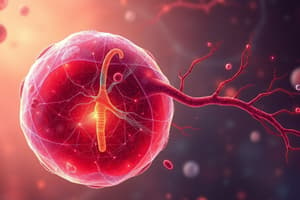Podcast
Questions and Answers
What is the primary purpose of aerobic cellular respiration in living cells?
What is the primary purpose of aerobic cellular respiration in living cells?
- To produce oxygen for cellular functions
- To convert ATP to ADP
- To obtain energy from glucose (correct)
- To remove carbon dioxide from cells
Which of the following correctly describes the process of gas exchange?
Which of the following correctly describes the process of gas exchange?
- Oxygen diffuses from the environment into cells directly
- Oxygen diffuses from the cells into tissue fluid (correct)
- Oxygen is transported from the tissues to the lungs
- Carbon dioxide enters the bloodstream from the air
What percentage of energy released during aerobic cellular respiration is stored in ATP molecules?
What percentage of energy released during aerobic cellular respiration is stored in ATP molecules?
- 20%
- 36% (correct)
- 50%
- 64%
Which process is involved in moving oxygen and carbon dioxide to and from the lungs?
Which process is involved in moving oxygen and carbon dioxide to and from the lungs?
In larger multicellular organisms, how is oxygen typically transported to cells?
In larger multicellular organisms, how is oxygen typically transported to cells?
What is the primary function of the respiratory membrane in the alveoli?
What is the primary function of the respiratory membrane in the alveoli?
Which part of the respiratory system is involved in filtering out dust and airborne particles?
Which part of the respiratory system is involved in filtering out dust and airborne particles?
What percentage of oxygen in the atmosphere contributes to the partial pressure at sea level?
What percentage of oxygen in the atmosphere contributes to the partial pressure at sea level?
What mechanism causes oxygen to diffuse from alveoli into the bloodstream?
What mechanism causes oxygen to diffuse from alveoli into the bloodstream?
What happens to carbon dioxide in the blood during gas exchange at the lungs?
What happens to carbon dioxide in the blood during gas exchange at the lungs?
Which hormone is produced by the kidneys to stimulate red blood cell production in response to low oxygen supply?
Which hormone is produced by the kidneys to stimulate red blood cell production in response to low oxygen supply?
What is the role of cilia in the respiratory system?
What is the role of cilia in the respiratory system?
What is the significance of vital capacity in lung function?
What is the significance of vital capacity in lung function?
At what altitude does the atmospheric pressure drop significantly, impairing oxygen transport?
At what altitude does the atmospheric pressure drop significantly, impairing oxygen transport?
Which of the following structures directly connects to a lung?
Which of the following structures directly connects to a lung?
What distinguishes the alveoli's structure related to gas exchange?
What distinguishes the alveoli's structure related to gas exchange?
What characterizes the mechanism of expiration?
What characterizes the mechanism of expiration?
What is the role of hemoglobin in oxygen transport?
What is the role of hemoglobin in oxygen transport?
What is the effect of carbonic acid in the bloodstream?
What is the effect of carbonic acid in the bloodstream?
What describes the typical temperature and moisture of air in the alveoli?
What describes the typical temperature and moisture of air in the alveoli?
Flashcards
Aerobic Cellular Respiration
Aerobic Cellular Respiration
The process by which cells use oxygen to obtain energy from food. It involves glucose reacting with oxygen to produce carbon dioxide, water & energy.
ATP (Adenosine Triphosphate)
ATP (Adenosine Triphosphate)
A molecule that stores and releases energy for cells to use in various processes.
Gas Exchange
Gas Exchange
The movement of oxygen into the body and carbon dioxide out of the body.
Gas Exchange in Lungs & Cells
Gas Exchange in Lungs & Cells
Signup and view all the flashcards
Ventilation (Breathing)
Ventilation (Breathing)
Signup and view all the flashcards
Respiratory Membrane
Respiratory Membrane
Signup and view all the flashcards
Ventilation
Ventilation
Signup and view all the flashcards
Alveoli
Alveoli
Signup and view all the flashcards
Hemoglobin
Hemoglobin
Signup and view all the flashcards
Partial Pressure
Partial Pressure
Signup and view all the flashcards
Oxygen Diffusion
Oxygen Diffusion
Signup and view all the flashcards
Carbon Dioxide Diffusion
Carbon Dioxide Diffusion
Signup and view all the flashcards
Tidal Volume
Tidal Volume
Signup and view all the flashcards
Inspiratory Reserve Volume
Inspiratory Reserve Volume
Signup and view all the flashcards
Expiratory Reserve Volume
Expiratory Reserve Volume
Signup and view all the flashcards
Residual Volume
Residual Volume
Signup and view all the flashcards
Vital Capacity
Vital Capacity
Signup and view all the flashcards
Erythropoietin (EPO)
Erythropoietin (EPO)
Signup and view all the flashcards
Altitude Sickness
Altitude Sickness
Signup and view all the flashcards
External Intercostal Muscles
External Intercostal Muscles
Signup and view all the flashcards
Study Notes
Aerobic Cellular Respiration
- Cells require oxygen for survival, using it to obtain energy from food.
- Aerobic cellular respiration is the process.
- Glucose reacts with oxygen, releasing energy, forming carbon dioxide and water.
- 64% of energy is released as thermal energy.
- Approximately 36% of the energy is stored in ATP (adenosine triphosphate) molecules.
- ADP + P + Energy → ATP (ATP formation)
- Cells use ATP for various processes like growth, movement, and building new molecules.
- ATP → ADP + P + Energy (ATP use)
Gas Exchange and Ventilation
- Gas exchange is the diffusion of oxygen into and carbon dioxide out of body cells.
- Simple organisms directly exchange gases via their cell membrane.
- Multicellular organisms use specialized systems to exchange gases.
- Gas exchange occurs in cells and lungs.
- In the lungs, oxygen diffuses from air into the bloodstream then cells.
- Oxygen diffuses from the blood into tissue fluid, then into cells.
- Carbon dioxide travels from cells to tissue fluid, then bloodstream, and lungs, finally diffusing out.
- Ventilation is the process of moving air to and from the lungs.
Respiratory Structures
- The human respiratory system has four key features: thin respiratory membrane, large surface area, good blood supply and a system to deliver oxygen-rich air.
- Lungs are the primary site of gas exchange, containing the respiratory membrane with a large surface area and rich blood supply.
- Lungs are enclosed within the thoracic cavity, protected by the rib cage.
Pathway of Air
- Air enters through the nose and mouth, warming and moistening in the nasal passages.
- Nasal passages have hairs and mucus to filter and trap particles.
- The pharynx is where the glottis stays open during breathing.
- The trachea (windpipe) is a semi-rigid tube with cartilage rings, keeping it open.
- Trachea is lined with mucus and cilia, sweeping away debris.
- Cilia are hair-like structures, propelling trapped particles upward via the trachea.
- Bronchi connect the trachea to the lungs.
- Bronchioles are smaller branches of bronchi, branching extensively.
- Alveoli are clusters of tiny sacs surrounded by capillaries.
- Each alveolus is extremely small.
- There are around 150 million alveoli in each lung.
Gas Exchange in the Alveoli
- Air in the alveoli is 37°C and saturated with moisture.
- Oxygen diffuses across the respiratory membrane when dissolved in liquid.
- Alveoli structures are ideal for gas exchange, membrane is one-cell thick.
Partial Pressures
- Air pressure is measured in kilopascals (kPa).
- Sea level air pressure is 101.3 kPa.
- Partial pressure is the pressure exerted by an individual gas.
- Oxygen makes up about 20.9% of air.
- Carbon dioxide comprises about 0.0391% of air.
Oxygen Transport and Diffusion
- PO2 in alveoli is about 13.3 kPa, which is higher than in capillaries.
- Hemoglobin is an iron-containing protein that binds to oxygen to form oxyhemoglobin.
- 98.5% of oxygen is carried by hemoglobin.
- Hemoglobin enhances oxygen carrying capacity significantly.
Cells
- Oxygen diffuses into body cells.
- In the veins, blood still contains some oxygen due to hemoglobin's capability to hold oxygen.
Carbon Dioxide Transport and Diffusion
- Carbon dioxide is a by-product of cellular respiration and needs removal.
- CO2 diffuses from tissues to blood.
- Three ways CO2 is transported: 7% as dissolved in plasma, 20% bound to hemoglobin, and 73% as bicarbonate ions.
- Hydrogen ions from carbonic acid affect blood pH.
- Increased CO2 in the body triggers increased breathing rate for removal.
- Hydrogen ions attach to hemoglobin to prevent blood acidity.
- In the lungs, bicarbonate and hydrogen ions are converted back to CO2 and water.
Altitude
- Reduced atmospheric pressure at higher altitudes lowers the partial pressure of oxygen.
- Altitude sickness results from decreased oxygen supply, causing symptoms such as shortness of breath.
- Kidneys produce EPO (erythropoietin) when oxygen supply is reduced.
- EPO stimulates red blood cell production increasing oxygen absorption.
Mechanism of Ventilation
- Inspiration: chest cavity expands, increasing lung volume, and decreasing lung pressure, drawing air in.
- Expiration: chest cavity contracts, decreasing lung volume, and increasing lung pressure, expelling air.
Lung Capacity
- Total Lung Capacity: maximum volume of air held.
- Tidal Volume: normal, involuntary breath volume.
- Inspiratory Reserve Volume: air forcibly inhaled after a normal breath.
- Expiratory Reserve Volume: air forcibly exhaled after a normal breath.
- Residual Volume: air remaining in lungs after forced exhalation (preventing collapse).
- Vital Capacity: maximum exhaled air volume.
Studying That Suits You
Use AI to generate personalized quizzes and flashcards to suit your learning preferences.




